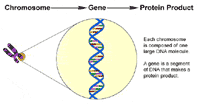Overview of Single Gene Defects
What are genes?
Genes are what determine your traits, such as eye color and blood type. They are contained on our chromosomes, which normally number 46 (23 pairs) in each cell of our body. There are an estimated 25,000 genes contained on these 46 chromosomes. Genes are made of DNA. DNA is an acronym for deoxyribonucleic acid. DNA is made up of base pairs that code for certain proteins. A gene, or a section of our DNA, makes a protein. There is also DNA in-between genes, which does not code for anything in particular, but simply serves as a "spacer." Therefore, not all of the DNA in our cells is used to make protein products.
Genes are found in pairs, just as the chromosomes are. One member of each gene pair is inherited from the mother, while the corresponding member of the gene pair is inherited from the father. Genes are expressed in different ways, and some genes are dominant over others. In other words, not all genes are always working at the same time. It depends on the combination of the gene pair inherited from the parents. Genes that are present on the first 22 pairs of chromosomes are said to be "autosomal." This means that both males and females are equally likely to have these genes. The last pair of chromosomes determine gender. Males have one X and one Y chromosome, while females have two X chromosomes. Therefore, women do not have any of the genes present on the Y, and men have only one copy of genes on the X.
The idea of inheritance was first described by an Austrian monk whose name was Gregor Mendel. Mendel performed experiments on garden peas, in order to determine patterns of inheritance. These basic patterns are sometimes called "Mendelian" or "traditional" inheritance. The basic patterns of inheritance are: autosomal dominant, autosomal recessive, and X-linked inheritance.

Connect with us:
Download our App: